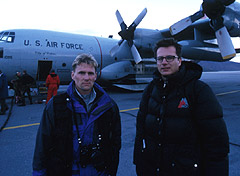|
Writer Gerald Traufetter
(at right) is an editor with the
science department of German
newsmagazine ‘DER SPIEGEL’.
He interviewed photographer
Marc Steinmetz on his work.
print version
text only, no pix, no links
|
|
Marc, you are widely known for your science
photography. Where does your interest in
science come from?
I have always been a curious person, and
my parents encouraged that. Even as a boy I
had a small microscope and a telescope. With
these I experimented and discovered the
world. I gave up my initial goal to become a
chemist or an astronomer quite early, though,
when things started getting more and more
theoretical. I quit chemistry when we hit
electron convergence in class. I mean: that’s
not even in my encyclopedia! I think I am
rather the generalist type.
But you do try to understand the things you
photograph?
At all events! It is essential that you
are
able to grasp complex concepts yourself
before you can even begin trying to explain
them to others. That is what good science
photography is all about.
|
|
How do you go about finding your images when
you work on a subject?
If I’m lucky I get enough time to
research
the subject in advance. Then, before I actually
start out on the assignment, I make a list of
all the images I need to illustrate the issue.
In the field I follow this preliminary outline of
my story and add any other images that may
come up.
This always takes a lot of thinking, so
I
don’t sleep too well on assignments because
of my constant brooding on what might be
missing or could be improved upon.
More often than not science isn’t all that
photogenic. Are there still ways to turn
profane lab reality into exciting images?
Interesting angles and wide angle lenses
might help. Sometimes I enhance smaller
objects in the foreground by using extremely
short focal lengths.
(continue...)
|

